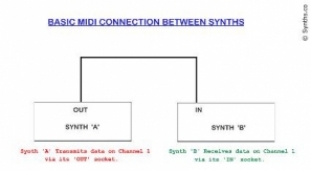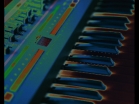The Birth Of MIDI
During the early-to-mid 1970's analog synthesizers could only communicate with one another if they were of identical CV/Gate parameters in the electrical sense, otherwise damage could easily occur to internal hardware circuitry which could prove very costly for musicians to get repaired, at the very least timing information would be garbled and music would regularly run out-of-sync between instruments, making it next to impossible to create coherent music.
In addition to this, synth manufacturers were quite rightly concerned over proprietary circuitry designs and were naturally reluctant to allow communication from their own devices to other manufacturers, so most equipment was only able to connect effectively with other equipment from the same manufacturer, unless musicians created their own interfacing devices (as quite a few did!).
By the later part of the seventies the major synth manufacturers, Dave Smith of Sequential Circuits, Dr.Robert A. Moog at Big Briar and Mr.Ikutaro Kakehashi of Roland initiating the principle, concluded that it would definitely be to everyone's mutual benefit, and in particular to the end user musician that 'all' their music creation products should be able to communicate, on at least some basic level, with instruments from 'any' other manufacturer.
In order to achieve this, they had to come up with a dedicated form of electronic circuitry and protocols to achieve this as a 'standard', so together with Roland, Yamaha, Korg, Moog, Casio and a number of other companies the UART (Universal Asynchronous Receiver Transmitter) was utilized. The UART (a semi-conductor packaged device) was capable of de-coupling electronic signals (voltage and current thresholds) by using opto-isolating technology, a means by which 'light' is used to basically transmit and receive on-off information in the digital sense ('1's and '0's). The opto-isolator eliminating any physical connection between the 2 differently operating circuits, with 'light' becoming the trasnmission medium instead. In much the same way as fibre-optic cables work.
This would allow, for example, a synth from manufacturer 'A' with an internal working voltage of 7 Volts DC and a 10 milliamp working current (because that's how the synthesizer's circuits had been originally designed), to be directly connected to a synth from manufacturer 'B' with an internal working voltage of 5 volts and a 5 milliamp working current (because that's how the 'other' synthesizer's circuits had been designed!), and for them to both stay in time and pitch with one another when 'sequenced' from one piece of gear.
The genius in midi was that the standard protocols could then be further expanded upon down the line by all the manufacturers with things like GM (General Midi Standardization) for 'all' home keyboards as well as synths, GM2, a further expansion of midi capabilities to include basic synth and effects parameter controls, XG, originally devoped by Yamaha as an additional extension to basic midi, then adopted by Korg and others. Many other methods and proprietary developments to extend midi further have since taken place, although not that much has changed in recent years besides the ability to use both hardware and software synths to operate in parallel with one another with unbelievable accuracy.

-
Synth 'A' Transmits data on Channel 1 via its 'OUT' socket.
- Synth 'B' Receives data on Channel 1 via its 'IN' socket.
The opportunity is always there for every new device that's created to utilize midi protocol to some extent, particularly where newer types of midi controller are now possible, which were barely even conceivable when the concept of midi first came about, such as using mobile phones like the iphone to make music with 'G' sensing transducers to control music software via midi, hand gestures on screened devices such as tablet computers, and in particular specialized movement detecting devices which allow disabled musicians to create music effectively, facilitated with this sort of midi controller technology all basically derived from the original idea of midi, the Musical Instrument Digital Interface.
Modern midi facilities on synths are now very comprehensive and vast, and continue to enhance as new developments and instruments arrive on the music scene.
